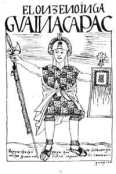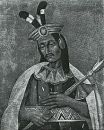Hello! This is part nineteen of a multi-part series on the Inca Empire and the Conquistadors. If you want some background, the introduction to this series is right here, and part eighteen is here. For those of you who like to have no idea what’s going on, go ahead!
When Almagro had been killed at the Battle of Las Salinas, he had left behind hundreds of men who had been his loyal followers. These men were spared execution, but they were left to languish on the margins of society in Pizarro’s Peru. Pizarro would not forgive Almagro’s supporters for fighting against him, so these men were unable to find any work in Peru. Unable to afford passage to a friendlier territory and unable to work for anyone in Peru, the Almagristas were trapped, left to starve and scrabble for a living in any way they could.
The Almagristas had been in Peru for almost as long as Pizarro, but they had almost nothing to show for it. They had arrived too late to share in Atahualpa’s ransom, and while Pizarro’s men had divided the wealth and land of the Inca empire they had fought for their lives in the freezing, poor, hostile provinces of Chile. They had won some wealth when Cuzco was looted, when they had split the gold and silver with Pizarro’s men, but they lost all their wealth and power when they were defeated at the Battle of Las Salinas.
No man felt more resentment and anger towards Pizarro than Diego de Almagro II, son of the late Almagro. Born in Panama to an unnamed Panamanian woman, Almagro II had accompanied his father for the entirety of his campaigns in the Inca Empire, joining him on his first expedition when he was barely a teenager. Almagro II had grown up on the warpath, fighting alongside his father all along Peru and Chile until his father’s defeat at the Battle of Las Salinas. Now Almagro II was a man, and he burned with hatred for Pizarro and all his followers. His time to strike would come soon.

In June 1541 a band of conspirators including Almagro II gathered in Lima. Things had reached desperate levels for the Almagristas, with their friends so poor and bereft they were starving in the streets. Even the Incas were treated better than the Almagristas, because Pizarro’s men at least depended on the Incas for manual labor. The Almagristas were clearly worthless to Pizarro and his men, and it was clear nothing would change as long as Pizarro was the governor. The solution, for the men gathered inside Almagro II’s house, was as simple as it was dangerous. They would kill Pizarro.
With Pizarro dead, the assassins argued, the king of Spain would be forced to send a new governor to rule over New Castille. This new governor would almost certainly be fairer towards the Almagristas then Pizarro. It was lost on none of the conspirators, least of all Almagro II, what would happen to them if they failed. None of the Pizarros were forgiving people. The assassins would have one chance at this.
On Sunday, June 26, 1541, twenty men gathered in Diego Almagro II’s house. They sharpened their blades, strapped on their armor and checked their equipment for any marks. Pizarro was known to go to mass every Sunday morning, always by the same route. The assassins planned to ambush the governor as he walked by himself through the streets of Lima.
Unfortunately for the conspirators, Pizarro had heard rumors of the plot. Pizarro was used to hearing of plots against him – The Almagristas had been horribly treated for two years, after all – and so he did not lend much credence to these rumors. However, the rumors convinced Pizarro that it would be wise to avoid going to mass that day. Instead he decided to have a priest come by his house to hear mass, and Pizarro also decided to invite over a number of his friends for lunch afterwards.
As they waited, eagerly and anxiously, the conspirators were suddenly informed that Pizarro had change his plans, and was at his house instead. Nervously, the would-be assassins argued over their next steps. Pizarro was no longer out on the streets, alone — he was now in the safety of his home, with the company of an unknown number of guests. Their odds of success had just dropped dramatically. At the same time, Pizarro was known to never miss a mass. If he had chosen to change his plans, he must know something of the plot. Did Pizarro know everything? Were his men already forming up in the streets, ready to descend on the house? If Pizarro suspected anything the conspirators needed to act quickly.
In the end boldness carried the day, pushed by Almagro II’s thirst for vengeance. The assassins would attack Pizarro at his house, and pray for success.
The assassins streamed out of Alamagro II’s house fully armed for war, twenty men lifting gleaming swords. They yelled as they ran through the town, swiftly closing the distance between them and Pizarro’s house.
Pizarro was enjoying a leisurely lunch on the second floor of his house with around twenty friends, including his half-brother Francisco Martin de Alcantara, slowly digesting his meal and talking pleasantly with his friends in the Peruvian heat. Suddenly a boy burst into the room, panting from exhaustion. He screamed that there were armed men coming to kill Pizarro!
Just then the assassins kicked down the door of the manor, streaming into the inner courtyard. Twenty armed conspirators poured into the courtyard, brandishing their weapons and screaming as they ran towards the stairs that led to Pizarro’s dining room. One of Pizarro’s pages was in the path of the assassins, and they quickly stabbed the boy and shoved his body to the side.
Pizarro’s guests now realized how serious this attack was, and they acted quickly. Almost all of them all of them fled, climbing out the windows, scaling out the balustrade or dashing further into the house to hide beneath large pieces of furniture, fleeing with what Cieza de Leon described as “great cowardice.” (MacQuarrie loc. 5600)

Pizarro, though, was made of sterner stuff. He, Martin de Alcantara, two of his pages and his guest Gomez de Luma quickly retreated to an adjoining room, where they began to arm themselves, strapping on their breastplates as quickly as possible. Another guest, Francisco de Chavez, attempted to go out to the assassins and talk them down, but as soon as he opened the door and stepped out he was immediately run through and the assassins poured into the room.
The Almagristas stormed through the dining room, yelling for Pizarro to come out and face them. Pizarro and his four companions, meanwhile, had retreated to a smaller room with a narrow doorway, where they waited for the assassins with drawn swords.
The assassins charged Pizarro with their blades held high, eager to strike down the man who had caused them so much pain. The music of swords clashing echoed through Pizarro’s mansion as the governor and his four men battled fiercely against the assassins. The assassins outnumbered Pizarro’s men by four-to-one, but the narrow doorway prevented them from bringing their full numbers to bear. Only five men could stand in the doorway at a time, and the assassins found themselves matched by Pizarro’s men. Pizarro, who was nearly seventy years old, more than held his own, and his men drew first blood: first one, then two conspirators were cut down in the first vicious skirmish. As the two Almagristas collapsed to the floor, bleeding out on Pizarro’s floor, two more men leaped forward to take their place.

The conspirators were growing desperate by this point. They still outnumbered Pizarro more than three-to-one, but they needed to kill him quickly. Any of Pizarro’s guests could have summoned the guards, and reinforcements could arrive at any time. Pizarro and his men showed no sign of tiring, and the narrow doorway was thwarting all their efforts. In a brutal gambit, the conspirators grabbed one of their own men and threw him directly at Pizarro’s leveled blade. The unfortunate Almagrista was skewered on Pizarro’s sword, but Pizarro’s sword was so deep in his body that Pizarro couldn’t free his sword quickly enough.
The assassins surged into the gap as Pizarro struggled to free his sword, slashing down at his defenders. Pizarro’s half-brother Martin de Alcantara fell, as did Pizarro’s guest Gomez de Luna, the only one of the governor’s guests who had the courage to stay and fight. Pizarro’s two unnamed pages fell as well, boys who had stayed and fought for their master. Pizarro finally freed his sword, but as he lifted the blade he was skewered through the neck and stumbled to the ground. The old governor continued to fight as the assassins slowly circled, inflicting wounds on several, but there were too many of them and he was surrounded. Again and again Pizarro was stabbed, swords and daggers slipping by his weakening defenses.

Finally Pizarro collapsed to the floor. As he lay in a pool of his own blood, the old conquistador slowly drew a bloody cross on his lips, letting his sword fall to the ground. One of the assassins, seeing this, yelled “You can go to Hell!” seized a large vase and brought it down on Pizarro’s head, crushing his skull. With a last shudder the conqueror of the Inca Empire breathed his last.
Pizarro, like his old friend Almagro, had a poor and meager funeral. His body was left in his house all day, and none of his friends dared to recover his body, for fear of Almagro II. At the end of the day one of his servants requested permission to bury Pizarro. The most powerful man in the New World was buried in a small church, with his servant forced to pay for the most rudimentary funeral expenses out of his own pocket. (de la Vega, loc. 21337)

Pizarro’s historical legacy is mixed, to say the least. Older chronicles and most of the primary sources such as Cieza de Leon and Garcilaso de la Vega paint a picture of a brave captain who fought bravely against impossible odds, leading his men bravely and with great valor. He conquered the Inca Empire, the most powerful empire of the New World, with a force of less than five hundred men. In addition, he brought millions of tons of gold into the Spanish economy and began the process that would lead to the conversion of most of the Inca Empire to Christianity, two accomplishments that his contemporaries in Spain lauded.
However, it is impossible to examine Pizarro’s accomplishments without also considering the horrific effects his expeditions had on the. Pizarro’s coming to the Inca Empire was nothing short of a disaster for the natives of the Inca Empire. While the Inca Empire had by no means been a utopian government, the Incas had at least ensured that their subjects had adequate food and clothing. Under the Spaniards, the natives worked as hard as they had under the Incas, but they got nothing back. (MacQuarrie loc. 5807)
There are the high-profile cases, such as the horrific treatment of Cura Ocllo at the hands of the Spaniards, but the general numbers are in fact more damning – by some estimates, the population of the Inca Empire declined from 7.5 million to 1.8 million in the fifty years after the conquest, a horrifying decline of more than 75%. (Hemming loc. 6045) Pizarro may not have killed all these natives himself, but he certainly did not stop the rape of native women and the torture and murder of natives, or do anything to prevent the mass death of native peasants due to Spanish indifference.
In the end, Pizarro comes across as a complicated figure. A great military leader and a deeply religious man who had no issue inflicting horrific atrocities on innocent civilians, a man who was deeply loyal to his brothers but callous and indifferent to some of his closest friends, a man who was frugal in everything but obsessed with maintaing his power. Peru would never be the same after he arrived, but whether that was a good thing depends very much on who you ask.
Dates
c. 1200 Kingdom of Cuzco is founded
1438-1471 Reign of Pachachuti
1471-1493 Reign of Tupac Inca
1492 Columbus discovers the Americas
1493-1527 Reign of Huayna Capac
1526 Pizarro and his thirteen men discover the Inca city of Tumbez
1527 Huayna Capac dies of smallpox brought by the Europeans
1527-1531 Civil war between Atahualpa Inca and Huascar
1531 Pizarro’s conquering expedition to Peru, Pizarro captures Atahualpa Inca, Atahualpa executes his brother Huascar
1533 Pizarro executes Atahualpa Inca and installs Manco Inca as the new Inca
1535 Pizarro founds the city of Lima
1536 Manco Inca rebels against the Spanish, leads a massive uprising that traps them in Cuzco and Lima. Juan Pizarro is killed in the battle
1537 Diego Almagro seizes Cuzco from the Pizarros. Manco Inca retreats from the capital to Vilcabamba
1538 Hernando Pizarro defeats and executes Almagro
1540 Hernando Pizarro is sentenced to twenty years imprisonment in Spain for killing Almagro.
1541 Pizarro is assassinated by supporters of Almagro
Characters
Incas

Huayna Capac – Emperor of the Incas [Died of plague in 1527]

Huascar – Son of Huayna Capac and the heir to the throne [Executed by Atahualpa in 1531]

Atahualpa – Brother of Huascar and rival for the throne, emperor of the Incas [Executed by Pizarro in 1533]
 Manco Inca – Younger brother of Atahualpa and Huascar, emperor of the Incas [Ruling in exile in Vilcabamba starting in 1537]
Manco Inca – Younger brother of Atahualpa and Huascar, emperor of the Incas [Ruling in exile in Vilcabamba starting in 1537]
The Pizarros

Francisco Pizarro – Oldest of the brothers and mastermind of the expedition. A talented leader of men and a good strategist [Assassinated by Diego Almagro II’s men in 1541]
Hernando Pizarro – Second of the brothers; a canny and calculating tactician [Sentenced to twenty years in prison in Spain in 1540]
Gonzalo Pizarro – Third brother; charming womanizer with a vicious cruel streak
Juan Pizarro – Youngest of the brothers and a powerful, impetuous soldier [Killed during the Siege of Cuzco by Manco Inca’s forces in 1536]
Almagristas

Diego Almagro – Partner with Pizarro and one of his oldest friends, a hardened veteran of many battles ready to strike it rich [Executed by Hernando Pizarro in 1538]
.jpg) Diego Almagro II – Almagro’s son, a hot-headed young soldier
Diego Almagro II – Almagro’s son, a hot-headed young soldier
Royalists
 Cristobal Vaca de Castro – Viceroy of Peru, a flexible and adaptable man
Cristobal Vaca de Castro – Viceroy of Peru, a flexible and adaptable man
 Blasco Nunez Vela – Viceroy of Peru, grating and brusque administrator
Blasco Nunez Vela – Viceroy of Peru, grating and brusque administrator
 Pedro de la Gasca – Viceroy of Peru, a clever politician and adept manipulator
Pedro de la Gasca – Viceroy of Peru, a clever politician and adept manipulator
One thought on “Chapter 19: The Death of Kings”